Themed collection Editor’s Collection: The application of quantum crystallography to solid-state pharmaceuticals

Terahertz spectroscopic characterization and DFT calculations of vanillin cocrystals with nicotinamide and isonicotinamide
Terahertz spectroscopic characterization and DFT calculations of vanillin cocrystals with nicotinamide and isonicotinamide.

CrystEngComm, 2023,25, 2038-2051
https://doi.org/10.1039/D2CE01642G
A quaternary solid-form of ritonavir: an oxalate salt oxalic acid co-crystal acetone solvate
Solid-state analysis of a new quaternary solid-form of ritonavir: an oxalate salt oxalic acid co-crystal acetone solvate.
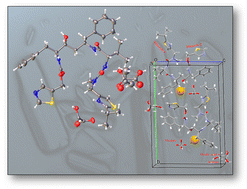
CrystEngComm, 2023,25, 1782-1791
https://doi.org/10.1039/D2CE01612E
Energy partitioning of pharmaceutical co-crystal structures
Energy partitioning of pharmaceutical cocrystals by molecule-pair interaction and ONIOM energies identifies the driving force of their formation, leading to in silico conformational sampling for predicting API-cocrystal combinations for experiment.
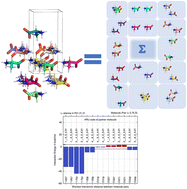
CrystEngComm, 2023,25, 1101-1115
https://doi.org/10.1039/D2CE00148A
Crystal engineering, electron density analysis, and in situ variable temperature studies on co-crystal between nicotinic acid and gallic acid sesquihydrate
The growth and thermal stability of the gallic acid : nicotinic acid cocrystal has been analyzed in terms of electron density analysis and conversion of GA monohydrate into anhydrate through heating the co-crystal.
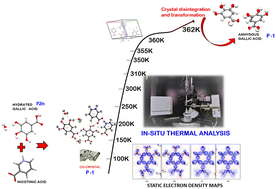
CrystEngComm, 2023,25, 770-784
https://doi.org/10.1039/D2CE01149B
Accurate experimental characterization of the labile N–Cl bond in N-chloro-N′-(p-fluorophenyl)-benzamidine crystal at 17.5 K
Very low temperature can preserve the photolabile N–Cl bond in a N-chloro-N-benzamidine derivative long enough to carry on an accurate experimental X-ray charge density study.

CrystEngComm, 2022,24, 6215-6225
https://doi.org/10.1039/D2CE00957A
Exploring halogen⋯halogen interactions in supramolecular self-assemblies of BODIPY networks
In this study, the efficiency of halogen⋯halogen interactions to control supramolecular assemblies of boron dipyrromethene (BODIPY) (B1–B5) derivatives was explored.

CrystEngComm, 2022,24, 5630-5641
https://doi.org/10.1039/D2CE00776B
Centroid⋯centroid and hydrogen bond interactions as robust supramolecular units for crystal engineering: X-ray crystallographic, computational and urease inhibitory investigations of 1,2,4-triazolo[3,4-a]phthalazines
The antiparallel π-stacked dimer of compound 6 (left) presenting a large dimerization energy (ΔE5 = −11.2 kcal mol−1) and confirming its relevance in the solid state of compound 6. 3D binding mode of 6 (right) docked in the catalytic domain of urease.
![Graphical abstract: Centroid⋯centroid and hydrogen bond interactions as robust supramolecular units for crystal engineering: X-ray crystallographic, computational and urease inhibitory investigations of 1,2,4-triazolo[3,4-a]phthalazines](/en/Image/Get?imageInfo.ImageType=GA&imageInfo.ImageIdentifier.ManuscriptID=D2CE00351A&imageInfo.ImageIdentifier.Year=2022)
CrystEngComm, 2022,24, 5324-5339
https://doi.org/10.1039/D2CE00351A
Combined computational/experimental investigation of new cocrystals of the drug bosentan
This manuscript reports the discovery of new cocrystals of bosentan, a drug used in the treatment of pulmonary artery hypertension, via a combined virtual/experimental cocrystal screening.

CrystEngComm, 2022,24, 5105-5111
https://doi.org/10.1039/D2CE00581F
Solid-state fluorescence of a quasi-isostructural polymorphic biphenyl based Michael addition product
Dimorphic biphenyl based Michael addition product displayed AIE in ethanol–water system and solid state owing to its highly twisted conformation. The quasi-isostructural nature of the two polymorphs resulted in identical photo-physical behaviours.
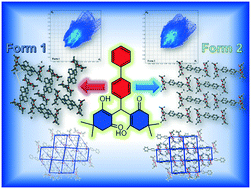
CrystEngComm, 2022,24, 4262-4273
https://doi.org/10.1039/D2CE00425A
Unravelling conformational and crystal packing preferences of cyclohexane-5-spirohydantoin derivatives incorporating a halogenated benzoyl group
The conformational and supramolecular diversity of spirohydantoins have been investigated.
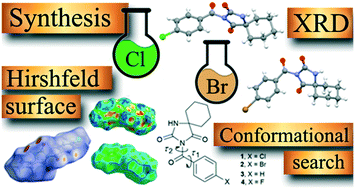
CrystEngComm, 2022,24, 4106-4119
https://doi.org/10.1039/D2CE00376G
Effect of substituents in novel bioactive tavaborole derivatives on the intermolecular interaction hierarchy
Tavaborole, a molecule based on the benzoxaborole scaffold, is an effective antifungal drug marketed under the Kerydin® trademark.

CrystEngComm, 2022,24, 3586-3596
https://doi.org/10.1039/D2CE00279E
Enhanced luminescence of single-benzene fluorescent molecules through halogen bond cocrystals
The formation of mixed stacking mode in the halogen cocrystals weakens the π–π interactions between DMCAT molecules and suppresses the aggregation-induced quenching effect, which in turn leads to enhanced emission.
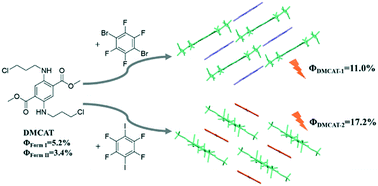
CrystEngComm, 2022,24, 3537-3545
https://doi.org/10.1039/D2CE00229A
Understanding the thermal stability of apalutamide crystalline solvates through crystal structure analyses and computational studies
The conformational flexibility of APA molecules leads to different crystal packing. The stability of the solvent molecules in the crystal structures was established through their strong intermolecular interactions with the host molecule.

CrystEngComm, 2022,24, 3511-3528
https://doi.org/10.1039/D2CE00216G
Combined crystallographic and computational investigation of the solvent disorder present in a new tipiracil hydrochloride methanol solvate–hydrate
We report a computational and crystallographic analysis of tipiracil hydrochloride (methanol solvate–hydrate). It shows a complex network of H-bonds with static discrete disorder in two out of the three symmetry-independent solvent molecules.

CrystEngComm, 2022,24, 3347-3354
https://doi.org/10.1039/D2CE00161F
Static discrete disorder in the crystal structure of iododiflunisal: on the importance of hydrogen bond, halogen bond and π-stacking interactions
We report a combined computational/crystallographic analysis focused on the static discrete disorder shown by the drug iododiflunisal.
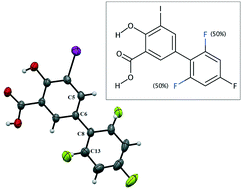
CrystEngComm, 2022,24, 3057-3063
https://doi.org/10.1039/D2CE00202G
Multi-component crystals containing urea: mechanochemical synthesis and characterization by 35Cl solid-state NMR spectroscopy and DFT calculations
This work discusses the mechanochemical synthesis and characterization of five urea multicomponent crystals by XRD, solid-state NMR, DFT and ab initio molecular dynamics calculations to provide insights into their molecular-level structures.

CrystEngComm, 2022,24, 2626-2641
https://doi.org/10.1039/D1CE01610E
Quest: structure and properties of BTF–nitrobenzene cocrystals with different ratios of components
Using the methods of quantum chemistry and AAP, the structure of BTF cocrystals with nitrobenzene, 1,2-, 1,3-, 1,4-dinitrobenzene, 1,3,5-trinitrobenzene, and hexanitrobenzene with different ratios of components (1 : 1, 1 : 2, 1 : 3, 2 : 1, 3 : 1) is modeled.

CrystEngComm, 2022,24, 235-250
https://doi.org/10.1039/D1CE00977J
About this collection
This Editor’s collection handpicked by Advisory Board Members Professor Simon Coles (University of Southampton, UK) and Dr Srinivasulu Aitipamula (Institute of Sustainability for Chemicals, Energy and Environment, Singapore) is dedicated to the rapidly growing field of quantum crystallography. Quantum crystallography supplements traditional crystal structure-solving techniques and aids in gaining deeper insights into material properties. In recent years, this interdisciplinary area of research has gained significant attention and is becoming an essential tool in the study of materials science, chemistry, and physics. Quantum crystallography is a field of crystallography that combines quantum mechanics and X-ray diffraction data to obtain more accurate and precise structural information and properties of solids. The process entails incorporating quantum-chemical data into X-ray refinements, thereby replacing the conventional spherical atom model and instead using techniques such as Hirshfeld atom refinement to better represent true electron density, all whilst still using standard X-ray data. Insights obtained through quantum crystallography have significant ramifications in comprehending the relationship between structure and properties. Firstly, it produces much more accurate crystal structures – and we expect it to soon become a routine refinement approach. Further, this technique also has widespread applications in the analysis of intermolecular interactions and properties of materials, such as pharmaceuticals, semiconductors, and many others. This themed collection features original research articles from experts in the field, highlighting the latest advancements and future directions of Quantum Crystallography in understanding the structure and properties of pharmaceutical-like materials and organic solids. The collection also highlights studies using Quantum Mechanical approaches with tools that are set to be used for Quantum Crystallography (e.g. QTAIM and NCI), giving a glimpse into the types of results that we can expect to see more of as the field matures and is more widely applied.